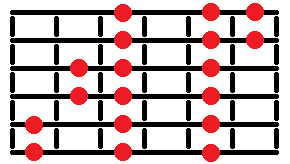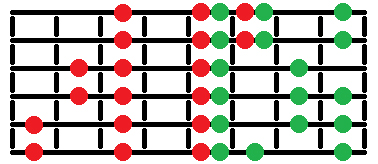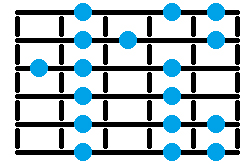Hopefully, the last few posts have taught you about modes and helped you understand how to see the different modes in actual guitar scales. Now it’s time to bring everything together.
All I ask of you in this post is to memorize three scale patterns. These three patterns will then connect to each other like a jigsaw puzzle in order to form the monster scale (as I like to call it). Guess what, if you’ve read the first two posts, you already know one of the three!
Yes, the first pattern to memorize is this Ionian pattern.
The second is a phrygian pattern. Remember, the phrygian mode takes the same form as a minor scale with a lowered 2nd.
Before you learn the third pattern, focus on those two. When you feel comfortable playing them both, it’s time to combine them. Phrygian is the mode you get by starting a major scale from its 3rd scale degree. Therefore, if you start the above phrygian pattern on the 3rd note of the above ionian pattern, you get this:
Do you see where I’m getting at here yet? By memorizing certain mode patterns you can piece them together like a puzzle.
Disclaimer: Please don’t get confused by the frets with two dots in them. No, the fret is not divided into micro-notes. I only included both dots to show that those notes are shared between the two patterns.
If you want to play in the key of G, all you have to do is position the first note of the ionian pattern on a G on the low E string. Once you do that, all of those above notes are fair game because they’re all in the key of G! Practice this combination of patterns as much as your brain can handle. Try playing up the ionian section of the pattern, but after you hit the last note play down the phrygian pattern. Come up with your own exercises, there are too many to count.
Yes you guessed it, once you have that under your belt it’s time to add another mode pattern. Now, you could start the next mode pattern from the note furthest to the right on the low E string, which corresponds to the 5th note of the major scale (which would be the mixolydian pattern). However, for visualization purposes I personally recommend skipping that one and adding the aeolian pattern. Don’t worry, the mixolydian scale will still be in there, but the aeolian pattern provides a more distinct way to divide this huge scale up in your head (you’ll see what I mean). Aeolian is also known as “natural minor”, and should be familiar to those of you who have practiced your minor scales. Since we’re connecting our notes on the low E string, we want an aeolian pattern that starts on the low E string. Here you go:
Start this pattern to the right of the 5th note on the low E string of the previous pattern. This is what it looks like:
Oh man, we’re getting serious here. So many frets! Every one of those colorful dots can be played in any one key.
“It’s like a whole new world!”
You didn’t think it ended there, did you? We now reach the best part of this whole mess of information. You know what’s cool about the musical scale? It’s cyclical! Once you get to the 8th note of the major scale, you begin playing that exact same scale in the next octave. Notice how on the low E string we have already covered eight notes. Do you know what this means?!?!? You can start this humongous pattern all over again:
Ladies and gentlemen, this is the beauty of the monster scale pattern. That black line on the bottom shows one place where the pattern repeats.
Hint hint: Do you see how many frets that black line spans? The notes on the guitar repeat every 12 frets. That’s why the 12th fret is almost always marked with a special inlay. This means that if you know where all the playable notes in a key are up to the 12th fret, you know where those notes are across the ENTIRE fingerboard!
If this huge bunch of notes is intimidating to you, just break it down into the different mode patterns. Remember, this isn’t a scale pattern that you have to memorize and play from left to right, bottom to top. The idea is to get away from the mentality that you have to play a confined scale pattern that spans 4 frets while you’re improvising. Think of it as all of the “playable” frets on the fingerboard lighting up for one specific key. You are free to play any of those notes!
Remember, this pattern can be started from anywhere on the fretboard. Whatever note you begin that ionian pattern on represents the major key in which you are playing in. If you want all of these notes to correspond with G major, place the first ionian note on a G! Remember, guitarists read these scale diagrams from left to right, bottom to top. When I say the “first” note in a pattern, I’m talking about the bottom-most, left-most note of that pattern.
Whew. I did my best to explain that as clearly as possible, but if you’re confused about anything please let me know. I’m happy to answer any questions or respond to any issues you may have. I suspect I’ll work a little more on this topic in the future.
Until then, let your fingers run free.






Great Job Dflo. Well put, excited to put this to use
Thanks, appreciate it!